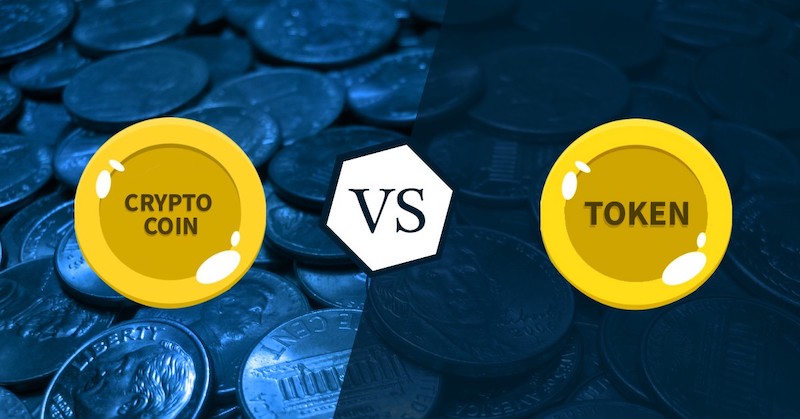
The cryptocurrency industry has too many jargons and words that are often used interchangeably, including token vs coin. For this reason, no one will send you to jail for not knowing the difference.
Table of Contents
Even renowned industry experts and writers often use both words as if they had the same meaning. But as you’d come to learn in this article, there is a technical difference between a crypto token vs coin.
What is Token?
A token is any digital asset created on the blockchain. It is usually issued or minted on another blockchain, often existing alongside several other tokens that belong to different projects.
Anyone can easily create a crypto token by writing a bunch of computer codes or even using automated tools.
What is Coin?
A coin is a cryptocurrency that runs on its blockchain. It is also referred to as the “native token” of the blockchain and often serves as a way for projects to pay transaction fees while building out their applications on the same blockchain.
Building out a blockchain requires many human and financial resources (millions of pounds), meaning that not everyone can launch a coin. However, anyone can create a crypto token and name it anything they want (LOL).
What is the difference between coins and tokens?
Going by the above definitions, you may already be able to tell some of the differences between crypto coins vs tokens. But we’ll highlight them in the list below so that you’ll have a clearer understanding:
- Coins have a native blockchain, while tokens do not.
- It is less expensive to create a token than a coin because the former lives on an existing blockchain.
- Tokens can eventually become coins when the project develops its own blockchain and migrate their tokens to the new blockchain as a coin. Successful migration cases include Binance Coin (BNB), Tron (TRX), Zilliqa (ZIL) which previously existed as tokens on the Ethereum blockchain.
Coins primarily serve as a payment cryptocurrency, while tokens on the other hand can serve a variety of use cases. For instance, have the following token classifications:
- Security tokens: Security tokens are digital assets that represent traditional “securities.” For instance, some security tokens represent company shares or bonds which they issue to raise funds from investors.
- Asset-backed tokens: These are tokens that represent assets that exist in the real world, for instance, a piece of real estate or tokenized versions of gold stored in a repository. Such issuance allows for these assets to be traded without any physical transfer of the underlying commodity.
- Non-Fungible Tokens (NFTs): NFTs are tokens that primarily work as collectibles. Users can create NFTs for almost anything, including art, baseball, virtual real estate, event tickets, etc.
- Tokenized Money (Stablecoins): These are crypto tokens that represent digital versions of a fiat currency. They are usually pegged 1:1 against the underlying currency, and thus always redeemable for the same value. Popular examples include USD Coin (USDC), Tether (USDT), and Gemini Dollar (GUSD).
Examples
Coins
Going by the differences between token vs coins, the following cryptocurrencies qualify as coins:
- Bitcoin (BTC)
- Ether (ETH)
- Litecoin (LTC)
- Monero (XMR)
- Tron (TRX)
- Binance Coin (BNB)
- Cardano (ADA)
- Zilliqa (ZIL)
We’ll use Ether (ETH) and Binance Coin (BNB) to further illustrate how crypto tokens differ from crypto coins.
Ether (ETH) and ERC-20 Tokens
Ether (ETH) is a coin and the ‘native token’ of the Ethereum blockchain. It is the second-largest cryptocurrency by market cap and is primarily used by developers and other network participants to pay for fees on the network.
The nature of the Ethereum blockchain, however, allows developers to create their own tokens on top of the network using a standard called ERC-20. Any token created on Ethereum, therefore, is rightly referred to as a ‘token’ and not a ‘coin.’ The coin title rightly belongs to Ether (ETH), the Ethereum network’s native cryptocurrency.
A good example of an ERC-20 token on Ethereum is the Basic Attention Token (BAT). BAT is used by the developers of the Brave Browser as a utility token, allowing users to earn money for viewing ads and advertisers to pay for ad spaces on the browser.
Other ERC-20 tokens on Ethereum include Chainlink (LINK), Tether (USDT), Wrapped Bitcoin (WBTC), Dai (DAI), Compound (COMP), and many others.
Binance Coin (BNB) and Binance Smart Chain Tokens
BNB (issued by the Binance exchange) was initially launched as an ERC-20 token on the Ethereum blockchain in 2017. However, Binance migrated the token to its native blockchain, Binance Chain, following its release in 2018. Thus, it fully adopted the name Binance Coin.
Today, BNB serves as a means for developers building on the Binance Smart Chain to pay for transaction fees.
Other tokens currently living on Binance Smart Chain include Wrapped BNB (WBNB), PanCakeSwap token (CAKE), Planet (PLNT), etc.
Coins vs Tokens: Final thoughts
An easy way to tell the difference between crypto coins vs tokens is to find out whether a cryptocurrency has a blockchain or not. If it has a blockchain, then it’s a coin, and if it doesn’t, then it’s a token.
Knowing this puts you in a better position to use the words correctly, either in writing or speaking to people about cryptocurrency assets.
Conclusion
As we noted at the onset, no one would send you to jail for not knowing the difference between tokens vs coins. At the same, though, we believe that the information shared in this article, you have given you a clearer understanding of the topic and you won’t be confusing tokens for coins or vice versa anymore.





 usdt
usdt bnb
bnb

